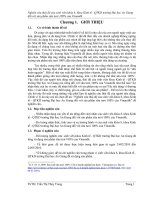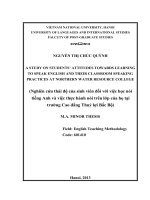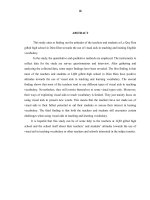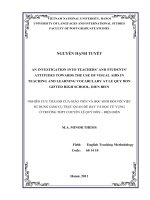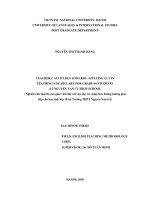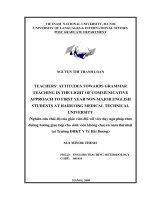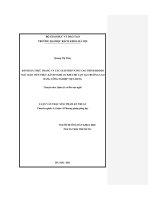Nghiên cứu thái độ của sinh viên đối với việc học nói tiếng Anh và việc thực hành nói trên lớp của họ tại trường Cao đẳng Thuỷ lợi Bắc Bộ
Bạn đang xem bản rút gọn của tài liệu. Xem và tải ngay bản đầy đủ của tài liệu tại đây (1.22 MB, 79 trang )
VIETNAM NATIONAL UNIVERSITY, HANOI
UNIVERSITY OF LANGUAGES AND INTERNATIONAL STUDIES
FALCUTY OF POST-GRADUATE STUDIES
NGUYỄN THỊ CHÚC QUỲNH
A STUDY ON STUDENTS’ ATTITUDES TOWARDS LEARNING
TO SPEAK ENGLISH AND THEIR CLASSROOM SPEAKING
PRACTICES AT NORTHERN WATER RESOURCE COLLEGE
(Nghiên cứu thái độ của sinh viên đối với việc học nói
tiếng Anh và việc thực hành nói trên lớp của họ tại
trường Cao đẳng Thuỷ lợi Bắc Bộ)
M.A. MINOR THESIS
Field: English Teaching Methodology
Code: 601410
Hanoi, 2013
VIETNAM NATIONAL UNIVERSITY, HANOI
UNIVERSITY OF LANGUAGES AND INTERNATIONAL STUDIES
FALCUTY OF POST-GRADUATE STUDIES
NGUYỄN THỊ CHÚC QUỲNH
A STUDY ON STUDENTS’ ATTITUDES TOWARDS LEARNING
TO SPEAK ENGLISH AND THEIR CLASSROOM SPEAKING
PRACTICES AT NORTHERN WATER RESOURCE COLLEGE
(Nghiên cứu thái độ của sinh viên đối với việc học nói
tiếng Anh và việc thực hành nói trên lớp của họ tại
trường Cao đẳng Thuỷ lợi Bắc Bộ)
M.A. MINOR THESIS
Field: English Teaching Methodology
Code: 601410
Supervisor: Dr. Mai Thị Loan
Hanoi, 2013
DECLARATION
This paper is submitted in partial fulfillment of the requirements for the degree of
Master of Education. I certify that this thesis is the result of my own research, and
that it has not been submitted for any other degree.
Ha Nam, September, 2013
Student‟s signature
i
ACKNOWLEDGEMENT
First and foremost, I would like to express my deepest thanks to my supervisor, Dr.
Mai Thi Loan, for her invaluable guidance, criticism and encouragement in the
process of completing this minor thesis.
I also wish to express my sincere thanks to all the lecturers of the Faculty of Post
Graduate Studies at University of Language and International Studies for their very
useful lectures.
My profound thanks also go to the teachers and the students at Northern Water
Resource College for their enthusiastic help and support.
Finally, I would like to express my gratitude to my loving family and my special
friends who always encouraged and helped me to complete this study.
ii
ABSTRACT
Attitude plays an important role in language acquisition and it helps explain
linguistic behaviour. Learners may have positive or negative attitudes towards
learning a language. Language attitude has great influence on language learning and
acquisition as well as learners‟ choice and use of language. Besides, speaking is
considered the most important skill that almost all the language learners want to
master. However, not all language learners have positive attitude towards learning
this skill. This thesis was carried out to investigate the students‟ attitudes towards
learning to speak English and their classroom speaking practices at Northern Water
Resource College. The data of the study were collected through a survey
questionnaire which involved the participation of 100 randomly collected samples
and four class observations. The data collected then were analyzed and generalized.
The findings of the research revealed that the students hold a negative attitude
towards learning to speak English. From the findings, some suggestions were given
with the hope that they might be useful for the teachers at Northern Water Resource
College to improve their students‟ English speaking skill.
iii
LIST OF ABBREAVIATIONS
NWRC: Northern Water Resource College
EFL: English as a foreign language
ELT: English Language Teaching
ESP English for Specific Purpose
iv
LIST OF FIGURES AND TABLES
Figure 1. Students‟ awareness of the importance of English speaking skill………
19
Figure 2. Students‟ assessment of their English speaking ability………………..
20
Figure 3. Students‟ feelings of speaking English…………………………………
20
Figure 4. Factors affecting students‟ learning to speak English…………………
22
Figure 5. Students‟ preferences for practising English........................................
24
Figure 6. Frequency of students‟ speaking in English class……………………..
27
Figure 7. Activities and methods teacher often uses in English speaking classes
29
Figure 8. Things teachers often do after giving speaking topics…………………
30
Table 1. Students‟ attitudes towards learning English…………………………….
18
Table 2. Students‟ willingness to speak English…………………………………
21
Table 3. Students‟ solutions to overcome difficulties in speaking English in class
23
Table 4. Students‟ ways to improve English speaking competence……………..
24
Table 5. Students‟ expectations for learning to speak English………………….
25
Table 6. The things that students often do in English speaking classes…………
27
Table 7. Students‟ ways to speak English in classroom…………………………
28
Table 8. Teachers‟ mistake correction …………………………………………… 31
v
TABLE OF CONTENTS
DECLARATION ………………………………………………………………
i
ACKNOWLEDGEMENTS………………………………………………….
ii
ABSTRACT…………………………………………………………………..
iii
LIST OF ABBREVIATIONS …………………………………………………
iv
LIST OF FIGURES AND TABLES…………………………………………..
v
TABLE OF CONTENTS…………………………………………………........
vi
PART ONE: INTRODUCTION……………………………………….........
1
1. Rationale of the study……………………………………………...........
1
2. Aims of the study…………………………………………….................
2
3. Research questions …………………………………………………........
2
4. Scope of the study ………………………………………………..........
2
5. Significance of the study……………………………………………........
2
6. Methodology………………………………………………………........
3
7. Design of the study………………………………………………..........
3
PART II: DEVELOPMENT……………………………………...................
4
CHAPTER 1. LITERATURE REVIEW……………………………...........
4
1.1. Attitudes...……………………………………………………............
4
1.1.1. Definitions of attitudes…………………………………………..........
4
1.1.2. Components of attitudes………………………………………...........
5
1.1.3. Functions of attitudes……....………………………………...............
6
1.1.4. Language attitudes………….…………………………………….......
7
1.2. Speaking theory……………........…………………………………...
7
1.2.1. Definition of speaking…………….........…………………………..
8
1.2.2. The role of speaking in foreign language teaching and learning….....
8
1.2.3. Problems with speaking skill……………………………………........
9
1.2.4. The techniques and activities in teaching speaking skills………........
10
1.2.4.1. The techniques in teaching speaking skills…………………….......
10
vi
1.2.4.2. The activities in teaching speaking skills……………………..........
11
1.3. Review of previous studies on attitude………………………..........
13
1.4. Summary………………………………………………………..........
14
CHAPTER 2. RESEARCH METHODOLOGY……………………...........
15
2.1. The setting of the study…....………………………………..............
15
2.2. Participants……………………………………………….................
15
2.3. Data collection instruments..………………………………..............
16
2.4. Data analysis procedure……………………………………….........
16
CHAPTER 3. DATA ANALYSIS AND DISCUSSION..........………….........
18
3.1. Questionnaires for students….…………………………………........
18
3.1.1. General attitudes of students at NWRC towards learning English…..
18
3.1.2. Students’ attitudes towards learning to speak English………..............
18
3.1.2.1. Students‟ awareness of the importance of speaking skill…..............
18
3.1.2.2. Students‟ assessment of their English speaking ability………….....
19
3.1.2.3. Students‟ feelings of speaking English…………...…………..........
20
3.1.2.4. Factors affecting students‟ learning to speak English………….......
22
3.1.2.5. Students‟ preferences for practising English.....................................
24
3.1.2.6. Students‟ expectations for learning to speak English……………....
25
3.1.3. Students’ classroom practices……………...……………………............
26
3.1.3.1. The frequency of students‟ speaking in English class ………..........
27
3.1.3.2. The things that students often do in English speaking classes…......
27
3.1.3.3. Students‟ ways to speak English in classroom………………..........
28
3.1.3.4. Teacher‟s teaching activities in English speaking classes……........
28
3.2. Classroom observations………………………………………..........
31
3.2.1. Teacher‟s methods and speaking activities …………………..........
35
3.2.2. Students‟ participation………………………………………….........
37
PART III. CONCLUSION AND SUGGESTIONS…………………….........
38
1. Summary of findings…………………………………………………..
38
1.1. Students‟ attitudes towards English and learning to speak English……
38
vii
1.2. Students‟ classroom speaking practices………………………………..
39
2. Implications for teachers……………………………………………….
39
3. Suggestions for further study…………………………………………..
41
4. Conclusion……...………………………………………………………..
42
REFERENCE…………………………………………………………...........
APPENDIX 1. Questionnaire for students............………………………………
43
I
APPENDIX 2. Class observation sheets…………..…………………………..... XI
viii
PART I: INTRODUCTION
1. Rationales
Nowadays, English is used for international communication more than any
other languages in the world. English is recognized as a lingua franca for
communication across nations and cultures and is the most desired second or
foreign language in most countries in the world. English is used as a second or
foreign language in the workplace, international trade, global media, tourism,
education, aviation, business, technology and on diplomatic occasions. As a result,
the demand for speakers using English effectively is necessary in every
country. Teaching and learning English, except for the native language, is thus
crucial for communicative purposes to meet the demands of global economics and
to cope with the growing local, national and international demands for English
skills.
In Vietnam, English is becoming more widely used in every field of life and it
is an official and compulsory foreign language which has been taught in most
schools and universities all over the country for nearly two decades now. People
thus have a great concern about learning the language. Many people are aware that
English guarantees them good jobs if they are good at English. Among the four
language skills known as listening, speaking, reading and writing, speaking skill is
considered the most significant one that most learners of foreign languages need to
achieve. The crucial importance of speaking skill has been stated by many linguistic
researchers. For example, Ur (1996:120) states that of all four skills, speaking
seems intuitively the most important and people who know a language are referred
to as speakers of that language, as if speaking included all other skills of knowing
that language. Richards (2008:19) also says: “the mastery of speaking skills in
English is a priority for many second and foreign language learners. Learners
consequently often evaluate their success in language learning as well as the
effectiveness of their English course on the basis of how well they feel they have
improved in their spoken language proficiency”. However, for many years, not
much attention has been paid to learners‟ speaking competence in Vietnamese
English classes and time for speaking practices is limited for many reasons.
Consequently, students have poor ability to speak English although they have been
learning English for a long time. They speak English badly even in English
speaking lessons. They often lack the confidence and feel confused when they are
1
asked to speak English. They regularly find it difficult to express their ideas in
English and even some students cannot speak anything but keep silent during
speaking lessons. Among many different factors that affect students‟ learning to
speak English in classroom, the attitude of the students has a very important
position.
This study has been conducted to investigate the attitudes of students at NWRC
towards learning to speak English and their classroom speaking practices in order to
offer some suggestions which might be useful for teachers and students here to
develop English speaking skills.
2. Aims of the study
This study aims at:
- finding out the attitudes of students at NWRC towards learning to speak English
- investigating the classroom speaking practices of the students at NWRC
- recommending some solutions for teachers at NWRC to improve their students‟
speaking skill based on the findings of the study
3. Research questions
1. What are the attitudes that students at NWRC hold towards learning to speak
English?
2. How are their classroom speaking practices?
3. What should the teachers do to improve their students‟ English speaking
skill?
4. Scope of the study
The study was carried out at NWRC with the participation of 100 first-year
students to find out the attitudes of students towards learning to speak English and
their classroom speaking practices. Based on the findings, some suggestions were
given to the teachers to help them improve their students‟ speaking skills.
5. Significance of the study
The result of the study is believed to help teachers at NWRC understand more
about the students‟ attitudes towards learning to speak English and their
expectations of the teachers‟ speaking lessons so that the teachers have suitable
2
methods to improve their students‟ speaking skills and encourage students to
practise speaking English in classroom.
6. Methodology of the study
To conduct this study, both quantitative and qualitative methods were used,
involving
the
survey questionnaires
and
classroom
observations.
The
survey
questionnaires were delivered to 100 first-year students to investigate their attitudes
towards learning to speak English. Besides, class observations were conducted to
see how and what students often did during English speaking classes. Classroom
observations helped the researcher survey students‟ practices in real situations so
that the reliability and validity of the data collected for this study could be achieved.
The data collected from the questionnaires and the result of class observations will
be analyzed and generalized with a hope for offering some suggestions for the
teachers at NWRC to improve speaking competence for their students.
7. Design of the study:
This thesis includes three main parts as follows:
Part I: Introduction
This part includes the rationales, the aims, the research questions, the scope, the
significance, the methodology and the design of the study.
Part II: Development
This part consists of three chapters:
Chapter 1: Literature review
In this chapter, the theoretical background of the study is introduced. It focuses
on three main points: theory of attitudes, speaking skills and some techniques as
well as activities that are often used in speaking lessons.
Chapter 2: Research methodology.
This chapter starts with the description of the setting and the participants of the
study. It also presents how data were collected through the research methods and
research procedures.
Chapter 3: Data analysis and Discussions
In this chapter, the data collected will be analyzed and discussed. From this,
students‟ attitudes toward learning to speak English will be found and their
classroom practices will be mentioned as well.
3
Part III: Conclusion and Recommendations
This chapter gives a short summary of findings and draws out some suggestions
that are good for teachers and students in teaching and learning to speak English.
Beside that, some recommendations for further researches are also discussed in this
chapter.
PART II: DEVELOPMENT
CHAPTER 1. LITERATURE REVIEW
In this chapter, the author will give an overview of the theoretical background
for the study. In the first place, the definitions, the components, the functions of
attitude as well as the concept of language attitude are discussed. Then, some issues
related to speaking such as definitions of speaking, the role of speaking in foreign
language teaching and learning, problems with speaking skills, the techniques and
activities in teaching speaking skills are presented. Finally, prior studies related to
the topic are also summarized.
1.1. Attitudes
1.1.1. Definitions of attitude
Attitude is a complex concept and there have been many definitions proposed to
describe its essence. Eagly and Chaiken (1993:1) define attitude as “a psychological
tendency that is expressed by evaluating a particular entity with some degree of
favor or disfavor”. This idea seems to have something in common with Ajzen‟s
viewpoint (1988:4, cited in Baker, 1992:11) which defines an attitude as a
disposition to respond favourably or unfavourably to an object, person, institution or
event.
Allport (1954:45, cited in Gardner, 1985:8) states that, “an attitude is a mental
and neural state of readiness, organized through experience, exerting a directive or
dynamic influence upon the individual‟s response to all objects and situations with
which it is related”.
Gardner (1985:9) claims that “attitude is an evaluative reaction to some referent
or attitude object, inferred on the basis of the individual‟s beliefs or opinions about the
referent”.
4
Lambert (Lambert & Lambert, 1973, cited in Porkaew, 2004:70) defines
attitude as “an original and consistent manner of thinking, feeling, and reacting to
people, groups, social issues or, more generally, to any event in the environment”.
According to Baker (1992:10), “attitude is a hypothetical construct used to
explain the direction and persistence of human behavior”.
In my opinion, attitudes are the feelings, thinking and beliefs of an individual
towards everything around him/her.
1.1.2. Components of attitudes
Attitudes play an important role in study in general and in language learning in
particular. According to Reid (2003:33), “Attitudes are important to us because they
cannot be separated from study”. There is a considerable amount of research on the
effects of attitudes toward learning on students‟ behaviors. Positive attitudes toward
any subjects are frequently found to enhance the students‟ interest in the subject and
their motivation to learn. And attitude is considered as an essential factor
influencing language performance.
There are different ways of distinguishing dimensions of attitudes. In general, it
is agreed that attitudes have three components. According to Harding (cf. Harding
et al. 1954, cited in Garner, 1985:8), attitudes have cognitive, affective and conative
components. Wenden (1991, cited in Karahan, 2007:75) sees attitudes as including
three components: cognitive, evaluative and behavioral components. Besides, many
researchers agree that attitude concept has three components, including behavioral,
cognitive and affective or emotional components. These three attitudinal
components are based on the three theoretical approaches of behaviorism,
cognitivism and humanism respectively. In the following, the researcher will take
the viewpoint of Saul McLeod (2009) and give a brief description of three
components of attitude concept from his viewpoint.
Behavioral/ conative component
It refers to the predisposition to act towards the attitude object in a certain way.
The behavioral aspect of attitude deals with the way one behaves and reacts in
particular situations.
Cognitive component
This aspect of attitude involves a person‟s beliefs/ knowledge about an attitude
object. The cognitive attitude can be classified into four steps of connecting the
5
previous knowledge and the new one, creating new knowledge, checking new
knowledge, and applying the new knowledge in many situations.
Emotional/ Affective component
It involves a person‟s feelings/ emotions about the attitude object.
This model is known as the ABC model of attitudes. The three components are
usually linked. However, there is evidence that cognitive and affective components
of behaviour do not always match with behaviour.
1.1.3. Functions of attitudes
Different psychologists have different ways of classifying functions of attitude.
Although several functions have been identified, the conceptualizations scholars
offer are similar to the functions established by Smith et al. (1956), Katz (1960),
and Herek (1987). Daniel Katz (1960, cited in Wikipedia) classified attitudes into
four different groups based on their functions, including four functions as follows:
Utilitarian: People adopt attitudes that are rewarding and that help them
avoid punishment. In other words, any attitude that is adopted in a person's
own self-interest is considered to serve a utilitarian function.
Knowledge: People need to maintain an organized, meaningful, and stable
view of the world. Important values and general principles can provide a
framework for our knowledge. Attitudes achieve this goal by making things
fit together and make sense.
Ego-Defensive: This function involves psychoanalytic principles where
people use defense mechanisms to protect themselves from psychological
harm. Mechanisms include denial, repression, projection and rationalization.
Value-Expressive: this function serves to express one's central values and
self-concept and to establish our identity and gain us social approval thereby
showing us who we are, and what we stand for.
However, Smith et al (1956, cited in Fazio & Olson, 2003:145) proposed an
„object-appraisal‟ function, which can be thought of as a combination of Katz‟s
utilitarian and knowledge functions. The object appraisal function is conceptualized
as attitudes that form as immediate evaluations of attitude objects. Another function
which he called the „externalization‟ function is similar to Katz‟s ego-defensive
function. The last function of attitude in Smith‟s theory is termed the „social
adjustive‟ function. This function reflects the ability of attitudes to promote or
6
maintain relationships with desired others or to highlight differences with disliked
others.
Despite different ways of classifying attitude functions, I myself prefer the four
functions of attitude offered by Katz because they are very clear and easy to follow.
1.1.4. Language attitude
Learning a language is closely related to the attitudes towards the languages
(Starks & Paltridge 1996:218, cited in Karahan 2007:75). In the Longman
Dictionary of Applied Linguistics (1992:199, cited in Karahan, 2007:75), language
attitudes are defined as the attitudes which speakers of different languages or
language varieties have towards each others‟ languages or to their own language.
Expressions of positive or negative feelings towards a language may reflect
impressions of linguistic difficulty or simplicity, ease or difficulty of learning,
degree of importance, elegance, social status. Attitudes towards a language may
also show what people feel about the speakers of that language.
In this study, language attitudes are understood as students‟ attitudes towards
learning a foreign language.
We can see that language attitudes have a great effect on the acquisition of a
language. Positive attitudes could enhance the process of language learning,
influencing the nature of students‟ behaviors and beliefs towards other languages, its
culture and community, and this will identify their tendency to acquire that
language.
Baker (1992:9) states that, “In the life of language, attitudes to that language
appear to be important in language restoration, preservation, decay or death”. In his
study, Karahan (2007:84) came to a conclusion that positive language attitudes let
learners have positive orientation towards learning English.
Despite its importance in language learning, students‟ attitude towards language
learning are influenced by many factors and to foster students‟ positive attitude in
ESL/EFL classes is not easy at all. According to Tsiplakides & Keramida (2010,
The Internet TESL Journal), students‟ attitudes towards language learning may be
affected by: a) teacher-student relationships, b) the general classroom atmosphere,
and c) the use of authentic teaching materials and activities.
1.2. Speaking theory
7
In language teaching, we often talk about the four language skills (speaking,
listening, reading and writing). Among them, speaking skill is considered the most
important skill because speaking ability is considered to be the measure of knowing
a language. According to Richards (2008:19), the mastery of speaking skills in
English is a priority for many second or foreign language learners and language
proficiency is used to evaluate learners‟ success in language learning as well as the
effectiveness of their English course.
From Nunan‟s point of view (Nunan, 1991: 39), for many language learners,
“mastering the art of speaking is the single most important aspect of learning a
second language or foreign language, and success is measured in term of ability to
carry out a conversation in the language”. Therefore, it is necessary for teachers of
language to pay much attention to teaching speaking skills in a way that helps
learners participate confidently in transactions.
1.2.1. Definitions of speaking
There are many different definitions of speaking. According to Florez (1999,
cited in Bailey, 2005:2), speaking is an interactive process of constructing meaning
that involves producing, receiving and processing information. It is often
spontaneous, open-ended and evolving.
Chaney (1998:13) states that speaking is "the process of building and sharing
meaning through the use of verbal and non-verbal symbols, in a variety of
contexts".
Brown (1994:245) defines speaking as a process of constructing meaning that
involves producing, receiving and processing information.
Bygate (cited in Mackey, 1965:266) shows that “oral expression involves not
only the use of the right sounds in the patterns of rhythm and intonation, but also
the choice of words and inflections in the right order to convey the right meaning”.
So, in the light of these definitions, in this study, the researcher will take the
idea that speaking is an interactive process of sending and receiving messages
successfully. It involves both linguistic and communicative aspects so that the
listeners can receive and process the information the speakers want to convey.
1.2.2. The role of speaking in foreign language teaching and learning
As we all know, speaking is one of two productive skills and it seems to be the
skill that almost all language learners want to master because their major aim of
8
learning the language is to use it to communicate with other people. As stated by Ur
(1996:120), speaking included all other kinds of knowing that language and many if
not most foreign language learners are primarily interested in learning to speak. So,
it is clear that speaking is the key component to English language teaching and
learning.
Bygate (1987:7) claims the role of speaking that it is the vehicle of social
solidarity, of social ranking, of professional advancement and of business and he
adds that speaking “is also a medium through which much language is learnt, and
which for many is particularly conductive for learning.”
It is clear that having good speaking skills help the learners have
communication which is the proper aim of language teaching. Once the learner
communicates well, he can get information from others about anything he would
like to know and being able to communicate successfully in a foreign language
helps people to take it easy and be confident to express themselves. Therefore,
speaking skills enforce and bring about the successful acquisition of reading,
listening and writing, in other words, the learning of English as a whole.
In conclusion, speaking skills hold a special and very important place in ELT.
The main goal in teaching the skill of speaking is oral fluency- that is the ability to
express oneself intelligibly, reasonably, accurately and without undue hesitation.
Having an effective speaking ability does not only help a learner acquire the
language better but communicate successfully and enrich his academic knowledge
as well. In order to attain this goal, it is necessary to give students an actual
language environment where they can use the language to express their own ideas.
Therefore, the teachers of English should pay much attention to teaching their
students speaking skills as well as offer them a rich language environment in class
so that the students can communicate meaningfully and fluently in English. This can
help improve students‟ ability to communicate in the target language clearly and
efficiently outside the classroom as well as contribute to the success of learners in
school and later in every phase of their life.
1.2.3. Problems with speaking skills
It is claimed that successful speaking ability should achieve a maximal student
talking time, even participation among students, students‟ strong motivation to
9
speak and comprehensibility of students‟ language. However, Ur (1996:121)
pointed some problems in getting learners to talk in classroom as follows:
The first problem with speaking activities is “inhibition”. It is explained that
unlike reading, writing and listening activities, speaking requires some degree of
real-time exposure to an audience. Learners are often inhibited about trying to say
something in a foreign language in the classroom because they are worried about
making mistakes, fearful of criticism or losing face, or simply shy of the attention
that their speech attracts.
The second problem in getting students to talk in the classroom is nothing to
say. Even if the students are not inhibited, the teachers often hear learners complain
they cannot think of anything to say. They may have no motivation to express
themselves beyond the guilty feeling that they should be speaking.
Moreover, uneven or low participation is among the teachers‟ obstacles. Only
one participant can talk at a time if he or she is to be heard. In a large group, this
means that each one has only very little time for talking. This problem is
compounded by the tendency of some learners to dominate the group, while the
others speak very little or not at all.
The final problem that is stated by Ur is the use of mother-tongue in classes. In
classes where all, or a number of the learners share the same mother tongue, they
may tend to use it. This happens because it is easier, because it feels unnatural to
speak to one another in a foreign language and because learners feel less „exposed‟
if they are speaking their mother tongue.
From these points we can see that in order to encourage students to talk in class,
the language teacher should create suitable activities to help students overcome
these obstacles so that they have more chances to talk in the classroom.
1.2.4. The techniques and activities in teaching speaking skills
1.2.4.1. The techniques in teaching speaking skills
In CLT, pair and group work activities are considered to be the most common
techniques used in a language classroom, in which students are allowed to interact
with each other so that they will be able to communicate in the target language.
Pair-work
Doff, A. (1988: 137) defines pair work as follows: Pair work is a process in
which “the teacher divides the whole class into pairs. Every student works with his
10
or her partner in pairs, and all the pairs work at the same time (it is sometimes
called “simultaneous pair work”). This is not the same as “public” or “open” pair
work, with pairs of students speaking in turn in front of the class.”
By working in pairs, students have more chances to practise the target language
because the working time is longer and the number of participants is bigger. When
working in pairs, students with low speaking competence can feel more confident to
speak without being afraid of losing face or being laughed at. Students can also help
each other to learn to speak. Besides, by using pair work, the teacher will have more
time to go round the class to help students when necessary and note down common
mistakes made by students so that the teacher can give feedback to the whole class.
In addition, working in pairs creates an actual language environment where students
can express their ideas in their own way. Therefore, students‟ speaking skill can be
improved.
Group work
Beside the definition of pair work, Doff (1988:137) also defines group work as
a process that “the teacher divides the class into small groups to work together (four
or five students in each group), as in pair work, all the groups work at the same
time.”
Similar to pair work, group work also has advantages mentioned above. It is a
cooperative activity during which students share aims and responsibilities. Group
work is more suitable for discussion tasks. It is more dynamic and informative than
pair work because of the greater number of students involving in the task. When
working in groups, students may feel more secure and free to express their ideas and
they can help each other when they share the ideas about the task.
1.2.4.2. The activities in teaching speaking skills
Many researchers discuss classroom activities and a lot of activities are
designed based on the theory and characteristics of CLT. Richards and Rodgers
(1986:165) discuss that the range of exercise types and activities with a
communicative approach is unlimited, provided that such exercises and activities
enable learners to attain the communicative objects of the curriculum, engage
learners in communication and require the use of such communicative processes as
information sharing, negotiation which involves the participation of all students. It
11
is suitable for discussion tasks which encourage students to share ideas and
knowledge.
Bailey and Savage (1995) design a lot of different activities to develop speaking
skills in the book New Ways in Teaching Speaking.
Among those activities, the followings are the most commonly used in the
speaking classes.
Information gap activities
In this activity, students are divided into pairs or groups. Each speaker has a
part of information making up a whole. Because they have different information,
there is a gap between them. They have to work with each other to find the
information to fill the gap by asking questions or describe and draw the picture or
memorize the order of things and so on. Each student plays an important part in
completing the task as the information cannot be completed if any partner does not
give the information he or she knows.
Role play
Harmer (1998:92) defines role-play as follows: “Role-play activities are those
where students are asked to imagine that they‟re in different situations and act
accordingly”.
Pattison (1987: 63) considers that most communication practices in the average
foreign language classroom involve an element of role-play because the speakers
pretend that the foreign language is their only means of communication. In his
definition, role-play may involve assuming a partly or wholly different person, and/
or pretending to be in a different situation.
According to Harmer (1998:87), having students take part in role-play activity
giving them a chance to rehearse having discussions outside the classroom. It is a
way for students to „get the feel” of what communicating in the foreign language
really feels like. Harmer (1998:94) also states that students may benefit a lot from
this kind of activity as it simulates a real-life encounter as if they were doing so in
the real world. As for Harmer, role-play is more than just play-acting: it offers
chances for rehearsal and Engagement that some other activities fail to give and
role-play can be used to encourage general oral fluency or train students for specific
situations especially when they are studying ESP.
12
Discussion
Discussion is one kind of speaking activity in which students are given a topic
by the teacher (or they can choose their own one), then they have a set of time to
discuss it. In a discussion, students have a chance to think of the ideas and the
language to express them. Harmer (1998:91) suggests that the best way of
encouraging discussion is to provide activities which force students to reach a
decision which is often the result of choosing between specific alternatives. “There are
many discussion possibilities. The important thing is that students need to be
Engaged with the topic. They then might do some study and move quickly to
Activate stages- which include the discussion itself. Almost certainly, however there
will be feedback, including Study, after the discussion is over”. However, during a
discussion, chaos may be an inevitable result and at the time the role of the teacher
as a controller becomes very important.
Discussion activities help learners practise what they have learned, find ways to
achieve objectives such as solving a problem, ranking objects, procedures and so
on. Through discussion, learners can also develop conversational skills such as how
to take turn, to change the topic of the conversation, to interrupt someone politely
and so on. Discussion in small groups also has some of the advantages as it does in
role play activities such as putting shy learners to ease to feel like speaking, giving
more opportunities for learners to speak, making learners more aware of their
responsibility to group success.
In short, the activities mentioned above do not cover all the activities teachers
use in the classroom. Many other activities can be used to encourage students to get
involved in the speaking lessons. It is necessary for language teachers to pay
attention to such speaking activities and exploit them effectively and suitably in order
to encourage students to take part in the speaking activities and develop their
speaking competence.
1.3. Review of previous studies on attitude
Many studies have been conducted to explore students‟ attitudes towards
learning a foreign language in general and learning English in particular in different
countries all over the world. Noursi (2013:22) has introduced many studies done by
researchers in different countries. For example, Musa (1985) investigated the EFL
students‟ attitude toward studying English in the United Arab Emirates using a five13
point scale questionnaire. The findings show that students had positive attitudes and
extreme eagerness towards learning English and they also valued the importance of
English language efficiency in the daily life. Besides, the findings of many other
previous studies (Vijchulata and Lee (1985) in Malaysia, Benson (1991) in Japan,
Mahboob's (2001) and Moussu (2002) in the USA, Arani (2004) in Iran, and
Karahan (2007) in Turkey) also show students‟ positive attitudes towards English
language and its learning.
At Vietnam National University, Hanoi- College of Foreign Languages, there
are also many M.A. theses on students‟ and teachers‟ attitudes towards various
aspects in English learning and teaching such as learning and teaching English
language skills or teachers‟ techniques used in teaching English skills as well as the
contents of textbooks, etc. For example, N.T.T. Hang (2006), T.T. Phuong (2007),
N.H. Tuyet (2009), N.T. Chung (2010) investigated students‟ and teachers‟ attitudes
towards teaching and learning vocabulary using different techniques. N.T.C. Ha
(2006), N.T.T. Loan (2006), T.T. Huyen (2008) focus on teachers‟ and students‟
attitudes towards teaching and learning grammar. B.T.T. Trang (2007), H.T.B.
Thuy (2008), T.T. Van (2010), etc. on teachers‟ techniques used in teaching English
skills. There are many other studies on teachers‟ and students‟ attitudes towards
teaching and learning different language skills. Among these studies, there is only a
study on attitudes of students at a high school in Bac Ninh towards learning to speak
English by B.T. Hien (2010). The findings showed that most of the respondents in
this study had negative attitudes towards learning to speak English. The researcher
also gave some reasons for these negative attitudes. From the findings, the
researcher provided some solutions for the teachers to motivate their students to
speak English in class.
1.4. Summary
This chapter has given some theoretical background knowledge concerning
definitions of attitude, language attitude and components as well as functions of
attitude. Besides, this chapter also introduces the theory of speaking, problems
related to speaking skill and techniques and activities often used by teachers during
speaking classes. Some previous studies in different contexts focusing on attitudes were
also covered in the chapter.
14
CHAPTER 2. RESEARCH METHODOLOGY
2.1. The setting of the study
The study was carried out at NWRC which is located in Ha Nam Province. This
college specializes in irrigational construction engineering. The college has about
350 first-year students. The students here come from different provinces in the north of
Vietnam.
The college does not have special rooms for students to learn foreign languages.
The reference books are very poor in the college library. In addition, the class size is
large with about 50 to 60 students in each class. Consequently, the teaching and
learning of English is limited.
English is a common and compulsory subject at this college. The students have
to learn totally 150 periods, of which 120 periods are for General English and 30
periods for ESP. In this college, the book New Headway Pre-Intermediate written
by John & Liz Soars is chosen to be the main course book for all the students at the
early stage (General English).
When students enter the college, they are at different levels of English language
proficiency. Most of them have studied English for at least three years but their
English is not very good. However, students are not divided into different groups
depending on their levels of language proficiency, because there has never been an
official examination to classify them. Besides, because of their long time of learning
English at high school, they are not considered as the beginners of English.
Accordingly, all of them take the same course with Pre-Intermediate level. In
addition, the limited class time and large class size, lack of reference books, etc. are
big problems for effective teaching and learning.
Speaking skill at this college is considered to be unimportant and students do
not have to take an oral exam at the end of each semester. All they have to do is to
take a written test to finish a term. Therefore, both students and teachers do not pay
much attention to developing speaking skill.
2.2. Participants
For the reason that at NWRC, English is only taught to the first-year students,
the sample in this study includes 100 first-year students, randomly chosen from
different classes. Because this is a college of construction engineering, there are
15
